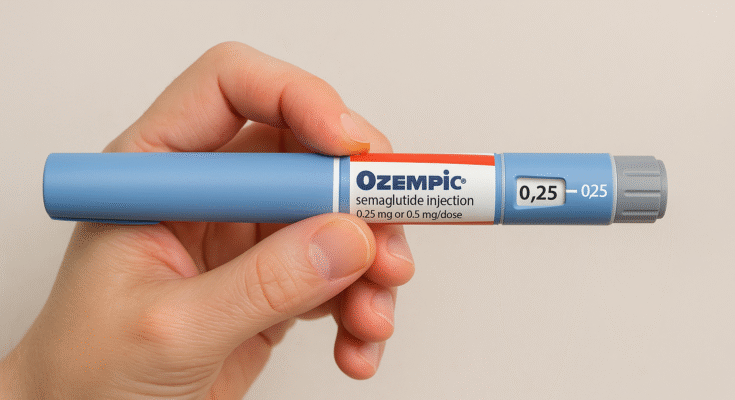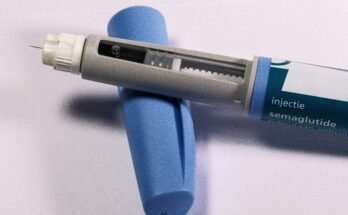If you’re navigating the world of Ozempic for type 2 diabetes management or, in some cases, weight loss, you’ve likely encountered the unique “click-counting” method for dosing. This injectable GLP-1 receptor agonist, known scientifically as semaglutide, has transformed diabetes care with its once-weekly administration and impressive ability to regulate blood sugar while potentially aiding weight management. But one question that frequently pops up, especially for new users, is: How many clicks does it take to get a 0.25 mg dose of Ozempic? As an expert in pharmacology and diabetes care, I’m here to demystify this process, guide you through the nuances of Ozempic pens, and empower you to use this medication confidently. Let’s dive into the mechanics of clicks, pens, and precise dosing, all while keeping things engaging and clear.
Understanding the Ozempic Pen: A Marvel of Precision
Ozempic is delivered via a prefilled, disposable pen designed for ease and accuracy, but it’s not as simple as pressing a button and injecting. The pen requires you to dial a dose by turning a selector, which produces audible “clicks” as it moves. Each click represents a tiny increment of medication, allowing for precise control over the dose. This is particularly important for Ozempic, as its dosing schedule starts low to minimize side effects like nausea and gradually increases based on your body’s response. The starting dose, 0.25 mg once weekly for the first four weeks, is meant to help your body adjust to the medication before moving to a maintenance dose of 0.5 mg or higher. But here’s where things get interesting: not all Ozempic pens are created equal, and the number of clicks needed for a 0.25 mg dose depends on the pen’s strength.
Ozempic pens come in different strengths, typically labeled by the total amount of semaglutide they contain and the doses they’re designed to deliver. The most common pens for initiating treatment are the red-labeled pen (delivering 0.25 mg or 0.5 mg doses, containing 2 mg of semaglutide in 3 mL) and the blue-labeled pen (delivering 1 mg doses, containing 4 mg in 3 mL). There’s also a yellow-labeled pen for 2 mg doses, but this is typically used for maintenance at higher doses. For someone starting at 0.25 mg, the red pen is usually the go-to, as it’s designed for the initiation phase. However, some patients receive a 1 mg pen (blue) due to availability or pharmacy preferences, which can complicate dosing if you’re not sure how to calculate the clicks.
Decoding the Clicks: How Many for 0.25 mg?
So, let’s get to the heart of the matter: how many clicks does it take to dial up a 0.25 mg dose? The answer hinges on the pen you’re using. For the red pen (2 mg/3 mL, delivering 0.25 mg or 0.5 mg), the dose selector is designed to stop at these marked doses, making it straightforward. Dialing to 0.25 mg typically requires about 18 to 19 clicks from the starting position, as each click delivers a small fraction of the drug. However, if you’re using a 1 mg pen (4 mg/3 mL, blue label), things get trickier because the pen is calibrated for a higher dose. In this case, studies and user reports suggest that 18 to 19 clicks also approximate a 0.25 mg dose, as the pen contains semaglutide at a concentration of 1.34 mg/mL, and the click mechanism is standardized across pens to deliver consistent increments.
Why the slight variation in click counts? It’s due to minor differences in pen manufacturing and user technique. Some sources, like patient communities on platforms such as Reddit, report 18 clicks for 0.25 mg on a 1 mg pen, while others suggest 18.5 clicks based on precise calculations (since 74 clicks deliver 1 mg, one-quarter of that is roughly 18.5). To be safe, always consult your healthcare provider or pharmacist to confirm the exact number of clicks for your specific pen, as small errors can affect dosing accuracy. The key is to turn the dose selector until you feel resistance or hear a distinct click pattern, ensuring you’re not over- or under-dosing.
Why Click Counting Matters
You might wonder why click counting is such a big deal. After all, can’t you just dial to the marked dose? For the red pen, yes, it’s that simple—0.25 mg is clearly indicated. But for patients using a 1 mg or 2 mg pen to deliver a 0.25 mg dose (often due to shortages or cost-saving strategies), click counting becomes a critical skill. This method, sometimes called microdosing, allows for smaller dose increments to reduce side effects or stretch a pen’s supply. For instance, if you’re sensitive to gastrointestinal side effects like nausea or vomiting, your doctor might recommend a slower titration, such as 0.35 mg, which requires counting clicks (e.g., 26 clicks on a 1 mg pen). This off-label approach, while evidence-based in some studies, should always be supervised by a healthcare professional to avoid dosing errors.
Click counting also gained popularity during Ozempic shortages, as patients sought to maximize their pen’s contents. A 1 mg pen, for example, contains 4 mg of semaglutide, enough for 16 doses of 0.25 mg or 8 doses of 0.5 mg if you count clicks carefully. This can be a cost-effective strategy, but it’s not without risks. The manufacturer, Novo Nordisk, warns that dosing by clicks isn’t officially supported, as it may lead to inconsistent dosing or product waste. The Australian Diabetes Educators Association echoed this caution in 2024, highlighting potential dose errors. Yet, with proper guidance, many patients and providers use this method successfully.
Tips for Safe and Effective Dosing
To master the click-counting method, start by familiarizing yourself with your pen. Check the label to confirm its strength (e.g., 2 mg/3 mL or 4 mg/3 mL) and ensure the medication is clear and colorless. Use a new needle for each injection to prevent contamination, and rotate injection sites (abdomen, thigh, or upper arm) to avoid skin irritation. Before injecting, wash your hands, clean the injection site with an alcohol swab, and attach a new needle. Turn the dose selector slowly, counting clicks audibly or visually, until you reach the desired dose. For a 0.25 mg dose, stop at 18 to 19 clicks, depending on your pen, and verify with your doctor or pharmacist if using a non-standard pen. After injecting, hold the needle in place for six seconds to ensure the full dose is delivered, then dispose of the needle safely.
Storage is another critical factor. Keep your Ozempic pen refrigerated before first use and at room temperature (up to 86°F) afterward, but discard it after 56 days, even if medication remains. If the dose counter stops before reaching your prescribed dose, the pen is empty or nearly so—switch to a new one. Never share pens or needles, as this risks serious infection. If you experience side effects like severe nausea or low blood sugar, contact your doctor immediately, as these may require dose adjustments or closer monitoring, especially if you have kidney issues.
FAQs
What happens if I miscount clicks and take the wrong dose?
Miscounting clicks can lead to under- or overdosing. Taking too little may reduce the medication’s effectiveness, while too much could increase side effects like nausea, vomiting, or hypoglycemia, especially if combined with other diabetes drugs. If you suspect a dosing error, check your blood sugar levels and contact your healthcare provider for guidance. To prevent mistakes, practice counting clicks with your pharmacist or doctor and double-check the dose counter.
Can I use the click method to save money on Ozempic?
Yes, some patients use click counting to stretch their Ozempic supply, such as getting 16 doses of 0.25 mg from a 1 mg pen. However, this should only be done under medical supervision to ensure safety and efficacy. Discuss cost-saving strategies with your doctor, and check if insurance or patient assistance programs can help. Always prioritize accurate dosing over cost savings to avoid health risks.
Is click counting safe for all Ozempic users?
Click counting is generally safe when guided by a healthcare professional, but it’s not recommended by the manufacturer due to potential dosing inaccuracies. It’s particularly useful for microdosing to manage side effects or during shortages, but patients with vision impairments or difficulty with fine motor skills may find it challenging. Always consult your doctor before using this method, and never adjust doses without their approval.
Conclusion
Navigating Ozempic dosing, especially the click-counting method for a 0.25 mg dose, can feel like learning a new language. But with the right knowledge and guidance, it’s a skill you can master. Whether you’re using the red pen (18–19 clicks for 0.25 mg) or adapting a 1 mg pen, precision is key to unlocking Ozempic’s benefits for blood sugar control and beyond. Always work closely with your healthcare provider to ensure safe, effective dosing, and don’t hesitate to ask for a demonstration or clarification. With this expertise in hand, you’re well-equipped to take charge of your diabetes management journey.

Lisa Caldwell is a clinical health writer and certified diabetes educator with a strong background in pharmacology and metabolic health. With over 12 years of experience in patient education, she specializes in translating complex research on GLP-1 medications like Ozempic into clear, practical guidance.




